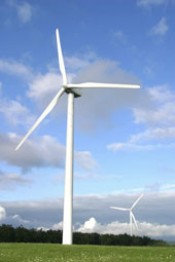By Henk Tennekes
Engineers cave in to green pressure, thanks to politically driven funding.
Wind energy is an engineer’s nightmare. To begin with, the energy density of flowing air is miserably low. Therefore, you need a massive contraption to catch one megawatt at best, and a thousand of these to equal a single gas- or coal-fired power plant.

If you design them for a wind speed of 34 miles per hour, they are useless at wind speeds below 22 mph and extremely dangerous at 44 mph, unless feathered in time. Remember, power is proportional to the cube of the wind speed. Old-fashioned Dutch windmills needed a two-man crew on 12-hour watch, seven days a week, because a runaway windmill first burnt its bearings, then its hardwood gears, then the entire superstructure.
This was the nightmare of millers everywhere in the “good” old days. And what did these beautiful antiques deliver? Fifteen horsepower at best, in favourable winds, about what a power lawn mower does these days. No wonder the Dutch switched to steam-powered pumping stations as soon as they could, in the late 19th century.
Since the power generated by modern wind turbines is so unpredictable, conventional power plants have to serve as back-ups. These run at less than half power most of the time. That is terribly uneconomical - only at full power do they have good thermal efficiency and minimal CO2 emissions per kWh delivered.
Think also a moment of the cable networks needed: not only a fine-maze distribution network at the consumer end, but also one at the generator end. And what about servicing? How do you get a repair crew to a lonely hillside? Especially when you decided to put the wind park at sea? Use helicopters - now that is green!
For that matter, would you care to imagine what happens to rotor blades in freezing rain? Or how the efficiency of laminar-flow rotor blades decreases as bugs and dust accumulate on their leading edges?
Or what did happen in Germany more than once? German legislation gives wind power absolute priority, so all other forms of generating electricity have to back off when the wind starts blowing. This creates dangerous, almost uncontrollable instabilities in the high-voltage network. At those moments, power plant operators all over Europe sweat blood, almost literally. The synchronization of the system is also a scary job: alternating currents at 100,000 volts or more cannot be out of phase more than one degree or so, else circuit breakers pop everywhere and a brownout all over Europe starts.
One application might be attractive, though. Suppose you fill a water basin in the hills nearby using wind power when it blows, and turn the water turbines on when emergency power is needed for one reason or another (a power plant failure, a cold winter night).
Wind power is a green mirage of the worst kind. It looks green to simple souls but it is a technical nightmare. Nowhere I have been, be it Holland, Denmark, Germany, France or California, have I seen wind parks where all turbines were operating properly. Typically, 20% stand idle, out of commission, broken down. Use Google Videos to find examples of wind turbine crashes, start meditating and reach your own conclusions.
Why don’t politicians listen to engineers? Why do engineers cave in to politically inspired financing? Merely to join the green daydreaming? I am an engineer; I want to be proud of my profession.
Henk Tennekes is an aeronautical engineer and the former research director of KNMI, the Dutch National Weather Service. This article was published today by The Pielke Research Group here.




